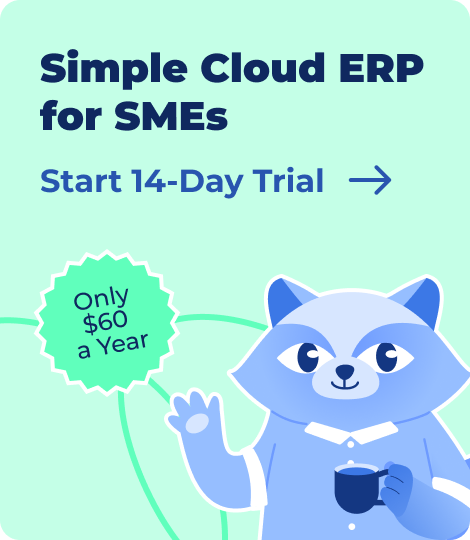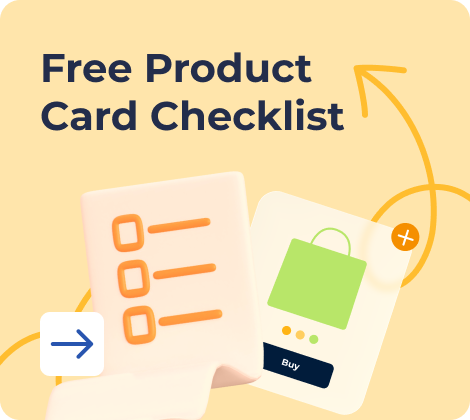B2B e-commerce businesses perform multiple activities: placing orders, negotiating prices, tracking deliveries, and more. It differs from D2C (direct-to-customer) e-commerce due to the quantity and repetitive nature of orders.
Also, there’s a long-term business relationship at stake because B2B businesses have repeated orders. The everyday tasks that move the needle include price negotiations, approval management, and delivery tracking across the complex supply chain management in e-commerce.
For instance, selling in a wholesale space would mean fulfilling bulk orders or distributing to regional partners. On top of that, you need account-specific catalogs, access permissions, and internal approvals.
That’s where you need B2B e-commerce software.
In a soon-to-be $3 trillion market (U.S), your business needs to make a cut. Here, choosing the right B2B e-commerce software can help sustain your business and even turn it profitable.
Let’s explore how B2B e-commerce software operates, the essential features, and tips for selecting the right one.
How Kladana Integrates Seamlessly with B2B E‑Commerce Platforms
✅ Real-Time Product Sync — New products created in Shopify or other platforms appear immediately in Kladana, with automatic updates to names, SKUs, prices, tax settings, and images.
✅ Live Stock Updates Across Channels — As soon as stock moves in Kladana via purchase, production, or sale, levels on Shopify reflect instantly, preventing overselling and fulfillment delays.
✅ Automated Order Import & Reservation — New B2B orders from Shopify sync directly into Kladana, reserving committed stock immediately and triggering fulfillment workflows.
✅ Custom Catalog & Pricing Support — Maintain unique catalogs or pricing tiers for different customer segments or platforms by integrating Kladana’s ERP pricing logic.
✅ Quote-to-Order Transition — Use Kladana to manage quotes and negotiation statuses offline or in CRM, then convert confirmed deals into Shopify orders automatically.
✅ Order Status & Customer Updates — Tracking numbers and shipping details update directly in Shopify from Kladana once orders are shipped, improving transparency and reducing support queries.
✅ Back-End Reporting & Profit Insights — View detailed sales analytics, including order-level profitability, SKU performance, and logistics, across all integrated platforms.
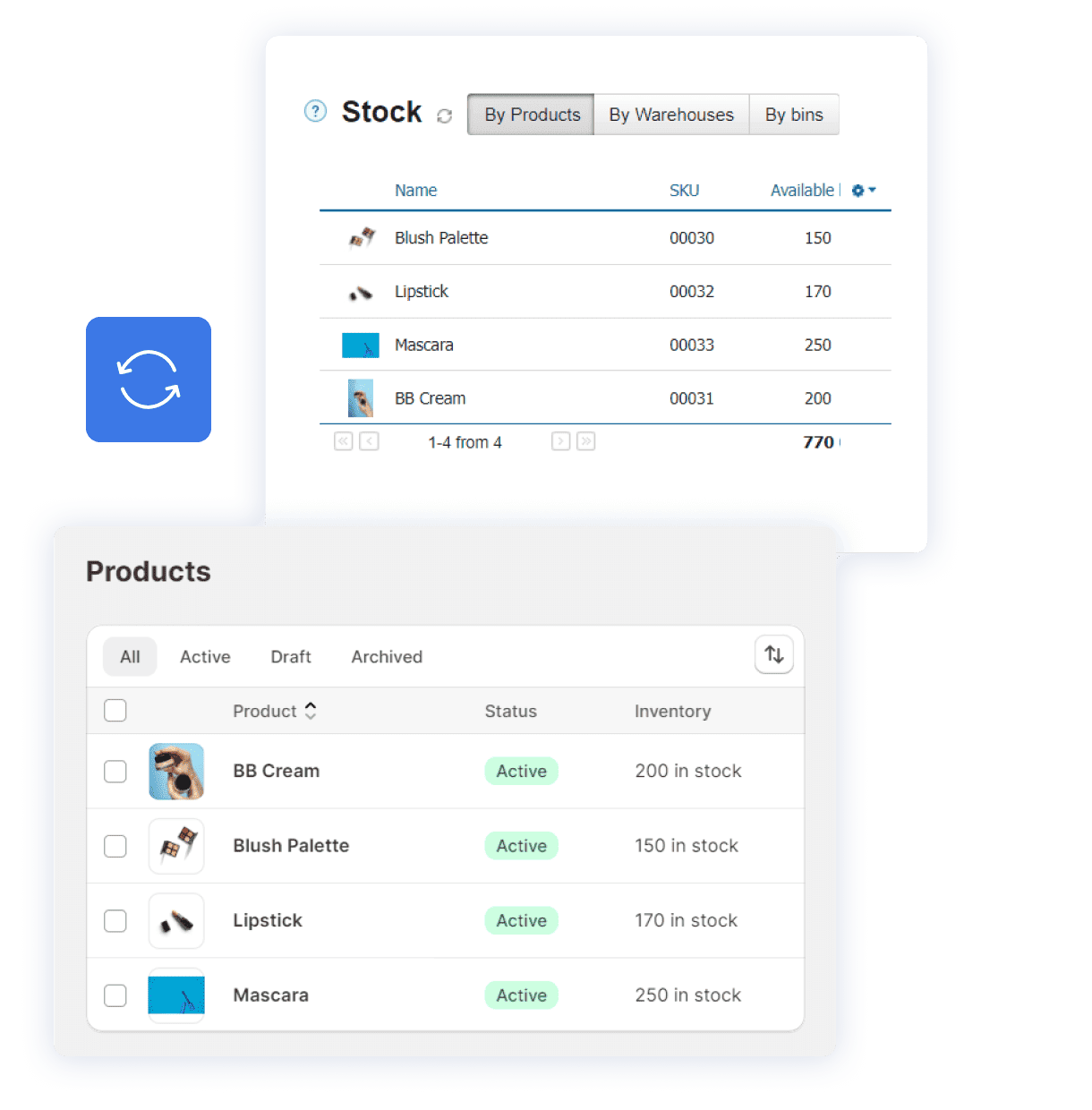
What is B2B E-Commerce Software?
B2B e-commerce software is built to handle sales that don’t fit inside a shopping cart — negotiated pricing, bulk orders, credit terms, internal approvals, and account-level permissions. Everything that slows down traditional ordering gets systemized, structured, and easier to scale.
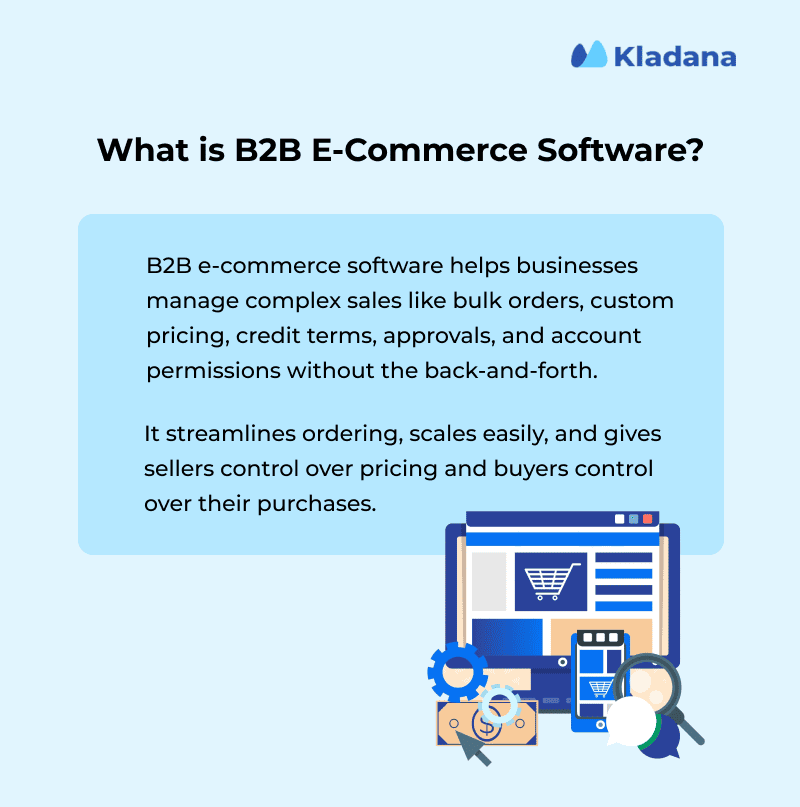
A strong platform gives your team control over pricing, fulfillment, and buyer access, while allowing your customers to handle their own quotes, reorders, and purchases without needing to send a single email.
Differences: B2B vs B2C E-Commerce Platforms
Most B2C platforms are designed for speed: serving one user, offering fixed prices, and facilitating quick checkout. That model breaks fast in B2B, where deals are larger, approval chains are longer, and no two buyers see the same catalog.
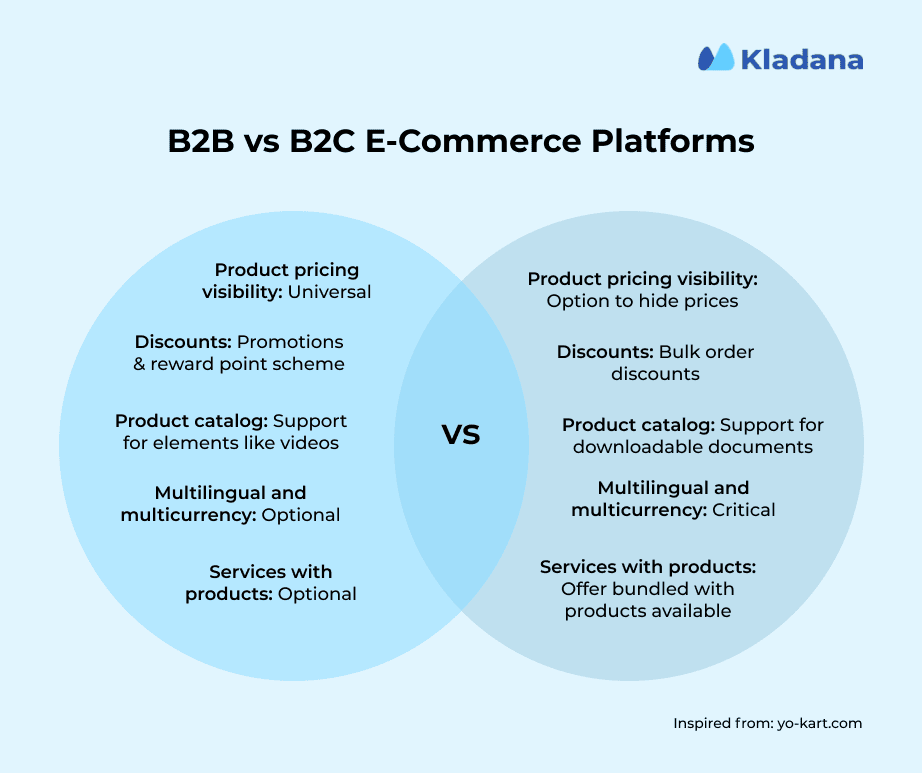
A B2C shopper might place an order in five minutes. A B2B buyer often requires a solid e-commerce inventory management system, avail manager approval, request a quote, and generate a PO before the order is even placed.
If your system can’t support that end-to-end process, you’re creating more work than you’re solving.
Here’s how the two compare:
| Feature | B2C E-Commerce | B2B E-Commerce |
Buyer Type |
Individual consumers |
Business accounts with teams |
Pricing |
Static, public |
Tiered, contract-based, negotiated |
Checkout |
Card-based, instant |
PO, credit terms, internal approval |
Catalog |
One-size for all |
Custom catalogs per buyer or segment |
Account Roles |
Not needed |
Multi-user with permissions |
Order Flow |
Add to cart, pay |
Request quote → approve → place order |
Payment Terms |
Pre-paid only |
Net 15/30/60, deposits, part-payments |
Inventory Sync |
Optional |
Critical for accuracy at scale |
Integrations |
Basic (shipping, payment) |
Deep ERP, CRM, production, and quote tools |
Sales Support |
Minimal |
Often hybrid (rep-assisted + self-serve) |
Top Features of B2B E‑Commerce Platforms
When choosing the best B2B e-commerce software, it’s obvious for decision-makers to look at the features and see if they can be of any use. What you’d typically check and determine is whether the features add up to business function bottlenecks.
For instance, can the B2B e-commerce software features help address the issues around slowed deals, cause fulfillment errors, or tie up your sales team in repeat tasks?
Here’s what to look for.
Custom Pricing & Catalogs
Pricing shifts based on contracts, order volume, customer location, and sales history. The platform should make it easy to assign unique price lists and custom catalogs to specific buyers or segments.
Use case:
A distributor in Johannesburg sees pricing tied to their contract terms. Their catalog reflects available SKUs, including delivery timelines and tax details, which are pre-set. Fewer calls, faster checkout.
Quote & Negotiation Tools
High-value or configured orders are often triggered with a quote. A strong B2B system should be able to manage quote creation, comments, revisions, and approvals within the platform.
Use case:
A procurement lead selects 100+ items and sends a quote request. The sales team updates pricing, adds notes, and returns quickly.
Bulk Ordering & Quick Reorder
B2B orders typically involve a large quantity, often comprising 50+ SKUs across multiple product lines. High-volume buyers rely on speed. They expect features like CSV uploads, SKU-based quick add, and saved order templates for repeat purchases.
Use case:
A regional retailer reorders 300 SKUs each season. Instead of starting from scratch, they log in, select their previous order, tweak a few quantities, and confirm within minutes.
Integration with ERP & CRM
A B2B software syncs your business inventory, production, payments, and customer records across multiple systems. Data flow across systems is crucial. This means the e-commerce software must synchronize both upstream (CRM) and downstream (ERP) data in real-time.
Use case:
Kladana connects directly with your e-commerce backend. Orders trigger inventory checks, reserve stock, initiate production, and update shipping ETAs automatically, ensuring every system remains aligned.
Payment Terms & Credit Limits
B2B buyers expect flexibility. They may pay on Net 30 or request milestone-based payments. Additionally, some accounts have credit limits, while others may require approval of purchase orders.
If a platform can’t handle that, finance teams end up processing orders manually, which doesn’t scale.
Collaborative Purchasing Transparency
Enterprise buying demands transparency. When procurement occurs across departments, teams need a clear view of what has been ordered, by whom, and when it’s arriving.
Say the maintenance team places an order for bolts and nuts, but the assembly unit has no visibility into it. If they plan production assuming stock availability, you’re looking at wasted time, halted schedules, and frustrated managers.
That’s why B2B e‑commerce platforms must offer role-based dashboards, shared order histories, and inventory-linked workflows.
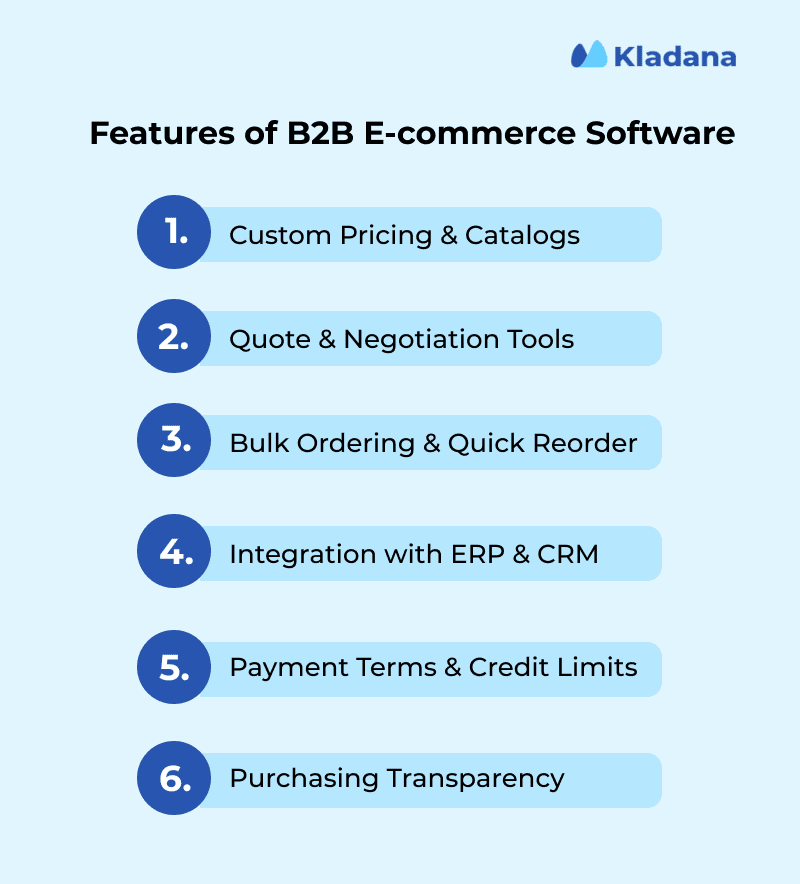
Feature checklist and its importance in a B2B space:
| Feature | Why It Matters in B2B |
Custom Pricing & Catalogs |
Personalized pricing and product visibility |
Quote Management |
Supports longer, negotiation-heavy sales cycles |
Bulk Ordering |
Handles large orders without slow manual entry |
Quick Reorder |
Speeds up recurring purchases |
ERP & CRM Integration |
Keeps backend systems aligned and reduces errors |
Payment Terms & Credit Handling |
Matches how B2B finance teams work |
Collaborative Purchasing Transparency |
Availing shared purchase & inventory visibility for teams to collaborate |
Multi-user Accounts |
Supports internal procurement workflows |
Approval Rules |
Prevents rogue purchases or unapproved spend |
Inventory Sync |
Ensures buyers only see what’s available |
Access Control |
Limits catalog visibility based on buyer roles |
Integrating B2B E-Commerce Software with Inventory & Operations
B2B platforms aren’t built to manage inventory, production, or procurement on their own. They rely on ERP systems to handle stock updates, purchase orders, and fulfillment behind the scenes. Seamless integration means every sale triggers real-time inventory updates, order reservations, and production workflows — with no manual intervention.
Kladana connects directly with your B2B e-commerce platform, syncing inventory, orders, and fulfillment in real time. Every order placed online automatically updates stock, reserves items, and triggers production or shipping workflows without manual work. This keeps your inventory, sales, and customer data fully aligned across systems.
Use case:
A distributor receives a bulk order via Shopify. Kladana syncs the order automatically, reserves stock, updates inventory levels, and pushes the shipping status once dispatched — all while keeping records aligned across sales and operations.
Best B2B E‑Commerce Platforms Compared
Evaluating platforms side by side gives you clarity. You get to weigh real features, pricing structures, use cases, and scalability, all mapped to your business needs. Below, you’ll find a breakdown of the leading B2B e-commerce platforms, including how they function and what they cost.
BigCommerce B2B Edition
BigCommerce B2B Edition is a bundled version of BigCommerce Enterprise, which can be beneficial for mid-to-large distributors, manufacturers, and wholesalers seeking speed to market without a fully headless approach.
Key Features
- Customer groups and shared accounts
- Company-level permissions and roles
- Request a quote with approval workflows
- Punchout catalogs, quick reorder, and bulk ordering tools
- Multi-storefront support
- Headless-ready via GraphQL and REST APIs
Pros
✅ Fast to launch with no-code and low-code workflows available
✅ Natively supports most common B2B functions
✅ Being a SaaS model, it reduces overhead and maintenance
Cons
❌ B2B Edition is built as an overlay, not a native platform. So, advanced workflows (e.g., multi-step quote approvals, inventory-based pricing, or PO validation) often require third-party apps or custom scripts
❌ Limited control over backend logic compared to open-source platforms
Pricing & Trial
Enterprise e-commerce plans are available based on request.
OroCommerce
Built from the ground up as a B2B-focused, open-source platform, OroCommerce is ideal for businesses that want to customize workflows and scale internationally.
Features
- Multi-tier pricing & price lists to assign granular costs per buyer group
- Advanced RFQ and quote revisions that support multi-stage negotiation
- Multi-site, multi-currency, and multi-catalog to manage global operations
- Workflow engine & API-first tool that customizes logic across checkout, approval, and email notifications
Pros
✅ Highly customizable to match unique B2B workflows
✅ Mature quote tools and global catalog control
Cons
❌ Custom dev needed for advanced workflows—locking approval logic, ERP connector tuning, UI adaptation
❌ Requires experienced developers and infrastructure to manage hosting, updates, and scalability
Pricing & Trial
Enterprise pricing is customized based on transaction volume and the number of admin users. You’ll need a request for a quote to unlock the actual pricing tiers.
Sana Commerce
Sana Commerce is an ERP-integrated e-commerce solution purpose-built for businesses using Microsoft Dynamics or SAP ERP systems. Unlike most platforms that sync ERP data after the fact, Sana runs directly off your ERP, acting as a source of truth for pricing, inventory, and order data.
Key Features
- ERP-native architecture (SAP and Microsoft Dynamics)
- Real-time stock, pricing, and customer data from ERP
- Custom catalogs and pricing per account
- Multi-site, multi-currency, and multi-language support
- Order history, shipping tracking, and invoices from ERP
- B2B payment terms support (P.O., invoicing)
Pros
✅ Real-time ERP sync avoids data duplication or timing mismatches
✅ Strong quote and account features out of the box
✅ Ideal for complex inventory environments
Cons
❌ Works only if you run Microsoft Dynamics or SAP
❌ UX customization is limited compared to headless or open-source platforms
❌ Feature development roadmap is often tied to ERP updates
Pricing and Trial
Sana offers three plans: Essential, Pro, and Advanced, with pricing to be requested based on order volume, ERP type, and add-ons.
Shopify Plus (B2B Features)
Shopify Plus is the enterprise version of Shopify that’s integrated with B2B tools under the new “B2B on Shopify” suite. It supports workflows such as account-based pricing, customer-specific catalogs, and purchase order checkouts within Shopify’s SaaS model.
Features
- Customer-specific pricing and catalogs
- Company profiles with multiple users
- PO-based checkout with payment terms
- Draft orders, manual quote support
- Separate wholesale storefronts or blended experience
- Integrations via API or apps for ERP and CRM
Pros
✅ Fast setup with native B2B features now built in
✅ Ideal for brands doing DTC and B2B in parallel
✅ Huge partner and app ecosystem
Cons
❌ Not built for deep B2B logic (e.g., complex approval chains, regional SKUs)
❌ Reliance on third-party apps for ERP sync or advanced quoting
❌ Limited backend customization for companies with non-standard workflows
Pricing and Trial
Shopify Plus is priced at $2,300/month (3-year term) or $2,500/month (1-year term) for the USA. Businesses outside the U.S. may see different rates depending on their location, currency, and contractual terms.
| Feature | OroCommerce | BigCommerce B2B Edition | Sana Commerce | Shopify Plus (B2B) |
Multi-tier pricing & price lists |
✅ |
✅ |
✅ (via ERP) |
✅ |
Advanced RFQ & quote revisions |
✅ |
✅ (basic) |
✅ |
✅ (draft orders) |
Multi-site, multi-currency catalogs |
✅ |
✅ |
✅ |
✅ (via storefronts) |
Workflow engine & API-first |
✅ |
✅ (GraphQL/REST APIs) |
❌ |
✅ (apps/APIs) |
Headless/API-ready architecture |
✅ |
✅ |
✅ (ERP-native) |
✅ |
ERP-native sync |
✅ (via integrations) |
❌ (via apps) |
✅ (SAP/Dynamics) |
❌ (via apps) |
Real-time inventory sync |
✅ (with connector) |
❌ (via apps) |
✅ |
❌ (via apps) |
Payment terms (PO, credit limits) |
✅ |
✅ |
✅ |
✅ (PO checkout) |
Bulk ordering & quick reorder |
✅ |
✅ |
✅ |
✅ |
Others: More B2B E-Commerce Platforms Worth Knowing
Here are a few other e-commerce platforms worth exploring.
Adobe Commerce (Magento): Highly customizable, Magento (under Adobe Commerce) is ideal for companies needing regional catalogs, approval logic, and complex negotiation features.
SAP Commerce Cloud: A tightly integrated B2B e-commerce tool that fits well with SAP ERP and CRM. Enterprises that require complex product configuration, pricing logic, and multi-region compliance can choose this.
Optimizely B2B Commerce (formerly InsiteCommerce): This one is designed for mid-market manufacturing, focusing on strong, out-of-the-box tools.
Tips for Choosing the Right B2B E‑Commerce Software
The best B2B e-commerce software reflects how your business sells: the buyers you work with, the workflows you follow, and the complexity behind every order.
Rather than chasing a one-size-fits-all solution, it’s smarter to match features with what matters most to your team.
Business Size & Complexity
Choosing the right B2B e-commerce software begins with understanding how your business operates and where complexity arises. For sales cycles involving quotes, account managers, or localized catalogs, look at platforms that support account-level logic.
Mid-sized teams often pick Shopify Plus or BigCommerce. Larger setups with custom workflows usually lean toward OroCommerce or Adobe.
Every B2B e-commerce software decision ties back to three core factors:
- Order complexity:
If your business handles negotiated contracts, repeat SKUs with varying specs, or bundles tied to delivery timelines, the platform should support rule-based pricing, quantity breaks, and auto-generated quotes. - Team structure
With multiple users placing and approving orders, you’ll need role-based permissions and order approval chains. The platform should reflect your org chart, not flatten it. - Market coverage
If you’re active across countries or tax zones, look for native support for multi-currency pricing, VAT/GST handling, and region-specific inventory management.
Implementation & Support
Decide if you can commit to a platform’s ecosystem. The majority of failure points don’t occur during demos; instead, they typically happen during onboarding, integration, and handoff between systems. So, consider these aspects over here:
Integration readiness
The platform should smoothly integrate your ERP with Kladana, SAP, or NetSuite and CRM, rather than relying on fragile workarounds.
Ownership model
Some platforms offer smooth onboarding and migration support. Others hand you the API documents and step away. Not having technical teams on hand means you need either a strong vendor or an implementation partner.
Ongoing support
Ticket-based support may be fine for low-volume teams. But running high-value B2B workflows may demand live support or account-based service.
ROI Considerations
Move beyond treating B2B e-commerce software as a cost center. Instead, check what it frees up. An ideal B2B platform reduces sales overhead, speeds up reorders, automates quotes, and cuts out email chains.
The ROI considerations will involve the following:
Quote-to-order automation
Buyers often need custom quotes before placing an order. With automation, you get quotes created, approved, and converted to orders — without emails or rep follow-ups. This speeds up the sales cycle and gives reps more time to close real deals.
Buyer self-service
Allowing buyers to manage their own pricing, reorders, and account-level controls reduces your support load and helps scale without headcount.
Inventory & fulfillment sync
If the platform can’t reflect real-time inventory from your ERP or warehouse, you’re risking backorders, overselling, and manual fire drills.
Here’s a comprehensive checklist for a quick reference:
| Decision Area | What to Look For |
Sales model fit |
The platform supports quotes, approvals, contracts, and pricing tiers out of the box |
Catalog flexibility |
SKUs and prices can be customized per region, customer, or contract |
Account structure |
Multi-user accounts, permissions, and team workflows are supported |
Inventory accuracy |
Real-time inventory sync with ERP or WMS is available |
Quote workflow |
Buyers can request, revise, and accept quotes inside the system |
Payment handling |
POs, net terms, invoice payments, and credit limits are fully supported |
ERP/CRM connections |
Your core tools (e.g., Kladana, SAP, Salesforce) integrate natively or via robust APIs |
Implementation support |
The vendor or partner guides the setup, not leaving it entirely to your team |
Support model |
Offers account-managed or responsive support, not just ticket queues |
Scalability |
The platform supports future product lines, markets, and buyer types without rebuilds |
Connect Your B2B Ecommerce Software to a Smarter ERP
Kladana integrates with your B2B e-commerce platform to sync product data, stock levels, and fulfillment steps in real time. From quote to delivery, keep every backend process aligned and efficient.
FAQs on B2B E‑Commerce Software
Let’s address some of the common questions around B2B e-commerce software.
What makes B2B e-commerce software different?
B2B e-commerce platforms are designed for account-based buying. They support complex pricing, quotes, approval chains, payment terms, and multi-user accounts.
Can B2B platforms handle complex pricing?
Yes. Most support tiered pricing, volume discounts, contract-based rates, and customer-specific catalogs.
How do quote and approval workflows work?
Buyers can request a quote instead of checking out a direct post which they can review, approve, and convert to orders without emails or manual entry.
Do B2B e-commerce platforms integrate with ERPs?
The better ones do. Tools like Sana and Oro offer deep ERP sync. Shopify and BigCommerce rely on middleware or APIs. Kladana can connect with most platforms for live inventory and production data along with various CRM software (Hubspot, Pipedrive, Zoho CRM, and Salesforce), e-commerce platforms (Shopify and WooCommerce), and accounting systems (Zoho Books and Xero.
What is the typical cost of B2B e-commerce software?
It varies widely. SaaS platforms like Shopify Plus or BigCommerce B2B start around $2,000–$3,000/month. Open-source or enterprise solutions, such as Oro or Adobe, range from $30,000 to $100,000+ per year, including setup costs.
How long does it take to implement?
Smaller setups can launch in 4–8 weeks, while more complex platforms with ERP or CRM integration typically take 3–6 months.
Can small businesses use B2B e-commerce platforms?
Absolutely! Provided the businesses have recurring orders, complex pricing, or client-specific terms.
How does multi-user account management work?
A single buyer account with multiple users, such as procurement, finance, and operations, may need different permissions. Some users create orders, others approve them, and admins oversee budgets or limits.
What payment terms can be managed?
B2B platforms support purchase orders, net terms (e.g., Net 30), credit limits, part-payments, and invoicing. These terms are typically associated with the buyer account and are integrated into ERP or accounting tools.
What’s the future of B2B e-commerce?
B2B e-commerce is moving toward self-service, personalization, and tighter ERP integration. Buyers expect consumer-grade UX but enterprise features such as live inventory, quote automation, and flexible payments.
Conclusion
The platform you choose ultimately shapes how your sales, operations, and fulfillment teams work together. A system that smoothly integrates into your pricing, inventory, and approval workflows reduces back-and-forth, catches mistakes before they occur, and keeps deals moving without manual intervention.
This is what strong B2B e-commerce looks like: clean processes, accurate data, and teams that aren’t fixing what the software should already handle.
If real-time inventory and production planning are part of your stack, Kladana’s e-commerce integration adds the control layer most platforms miss. It keeps your order flow aligned with what’s actually in stock, so buyers don’t guess and your team doesn’t scramble.
The proper setup doesn’t feel heavy. It just works the way your business already does.
List of Resources
Forrester — US B2B E-Commerce Will Reach $3 Trillion By 2027
